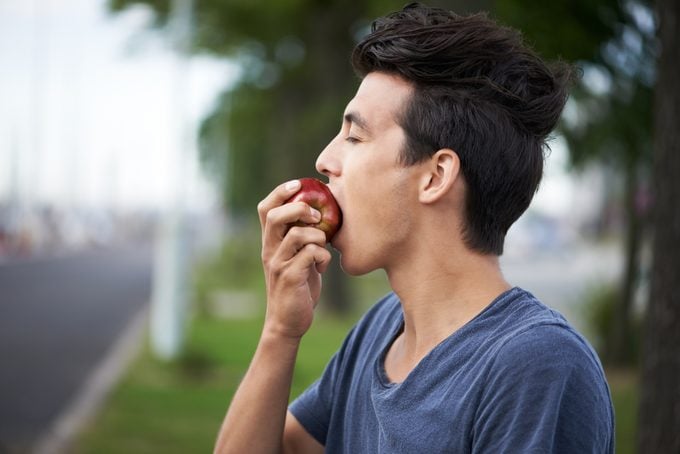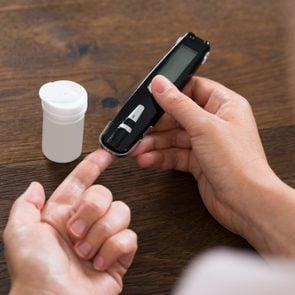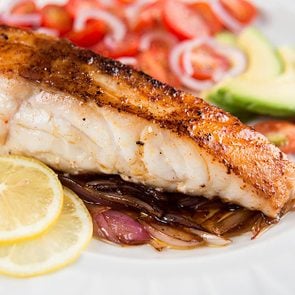Snacks for People With Diabetes: 12 Expert Tips for Healthy Snacking
Updated: Oct. 12, 2022
The danger of snacks for people with diabetes is that they can become like an extra meal. Here are some expert tips for healthy snacking.
Our editors and experts handpick every product we feature. We may earn a commission from your purchases.
If you have diabetes, you may be worried you have to forfeit snack time. But don’t worry, “snacking definitely isn’t off-limits,” assures Erin Palinski-Wade, RD, a certified diabetes educator and author of 2-Day Diabetes Diet. “Think of snack time as an extension of your meals.” In fact, snacking should be a go-to strategy for helping to manage your blood sugar levels.
“Snacking during the day is beneficial to blood sugar, not harmful,” says Palinski-Wade. “Snacking between meals, especially meals spaced far apart, is a helpful way to balance blood sugar levels and prevent them from dropping. Snacks can also help to regulate your appetite, so you don’t become too hungry and overeat at the next meal—which may spike blood sugar levels. Now, read on for a dozen expert tips for snacks for people with diabetes to help you satisfy your in-between meal cravings the healthy way. And remember, stress, lack of sleep, and how much exercise you get in a day can also affect blood sugar levels.
Eat your snacks
The number one rule of snacking for people with diabetes? “Don’t skip snacks,” says Palinski-Wade. “Not only can regular snacking help to keep blood glucose levels stable, but it can also curb hunger helping to manage portions at your next meal.” Love meals more than snacks? That’s no problem. “Snacks don’t necessarily have to be traditional snack foods,” she says. “You can enjoy half of an avocado, half of a sandwich, or even a garden salad topped with nuts and beans.”
Include a slow-digesting nutrient
You probably know it’s important to eat protein, healthy fat, and fiber. Ever wonder why? One of the major reasons is these nutrients are slow digesting. Therefore, when it comes to snacks for diabetics, Palinski-Wade suggests it should include at least one slow-digested nutrient. “If you were snacking on crackers, it would be best to combine them with nut butter or part-skim cheese for a source of protein or fat to keep you full longer.” Also, be sure to always keep your blood sugar steady.
Eat fiber-rich carbs
Great news: Carbohydrates aren’t off the table, there are good carb snacks for people with diabetes “Snacking on carb-rich foods are fine, as long as they are rich in fiber,” says Palinski-Wade. “You don’t need to avoid carbs to manage diabetes. But you do need to make wise choices with the carbs you select. Fiber-rich options such as crunchy chickpeas, beans, and even steel-cut oats can provide a slow-digested source of carbs to keep blood sugar steady.” That means a white bagel isn’t the best snack choice. Aim for about 15 to 30 grams of carbohydrates in a snack, advises Palinski-Wade.
Time your snacks
“If you know you will go too long between eating meals, which can affect your blood sugar, make sure to plan ahead for snacks,” says Toby Amidor, RD, author of The Create-Your-Plate Diabetes Cookbook. So how often should you be eating? “For the best blood sugar management, aim to eat at least every four to five hours to prevent drops in blood sugar and energy levels,” says Palinski-Wade. “A good rule of thumb is to space meals out about five hours and plan for a snack in between each meal. So then you are eating a small meal or snack about every two-and-a-half to three hours.”
Keep it snack-sized
“When you’re famished, it’s easy to overdo it,” says Shahzadi Devje, RD, a certified diabetes educator in Toronto, Canada. “Portion size matters! If you’re eating meal-size portions as snacks regularly, this will inevitably impact your blood sugar control, not to mention your weight.” The exact calorie make-up of your snack depends on factors such as how many snacks and meals you’re eating throughout the day and how much you’re exercising. You can either purchase pre-portioned snacks, or you can separate larger bags of snacks into reusable single-serving containers when you get home from the grocery store.
Add a fruit or vegetable
Produce brings fiber and nutrients to the plate. You have so many options to choose from. “Grapes are a low-glycemic fruit and can easily fit into a balanced diabetes diet plan,” says Amidor, a nutrition partner with Grapes of California. “A half-cup of grapes or about 10 grapes is considered one serving. You can also enjoy grapes frozen, as they taste like a mini sorbet but with no added sugar. Simply rinse, pat dry, then pop them into the freezer for two hours.” Other good options for fruits and veggies include apples, pears, berries, bell peppers, carrots, tomato, and broccoli. Make sure to pair produce with a healthy fat or protein, such as a couple of tablespoons of nuts. Other produce-rich snack options include apple slices dipped in almond butter, carrot sticks with hummus, or tomato slices paired with mozzarella cheese. Here’s what experts need you to know about glycemic load vs. glycemic index.

Eat the skin
Did you know most of a fruit or veggie’s fiber is found in the skin? For example, a medium apple with skin contains about four grams of fiber, according to the U.S. Department of Agriculture. Without the skin? You’d only get about half the fiber in a peeled apple. In addition to helping you feel fuller, soluble fiber may help control blood sugar levels and insulin resistance in people with type 2 diabetes, according to a May 2016 study in Experimental and Therapeutic Medicine.
Beware of low-fat snacks
“Typically if you take out the fat [in a processed food], you add carbs or sodium,” says Sacha Uelmen, RD, managing director of diabetes education and nutrition for the American Diabetes Association. At least, this is the case with most non-dairy foods. For instance, two tablespoons of reduced-fat peanut butter contain 166 calories, 11 grams carbs, 11 grams fat, and 173 milligrams sodium. On the other hand, two tablespoons of regular peanut butter have 191 calories, 7 grams carbs, 16 grams fat, and 136 milligrams sodium. (Get nutritionists’ tips for grocery shopping with diabetes.)
Do a hunger check
“Check to see if you actually need a snack due to hunger or if you’re just looking to munch on something,” says Vandana Sheth, RDN, certified diabetes care and education specialist and author of My Indian Table. Yup, boredom hunger is a thing. If you’re not actually hungry, there’s a chance you’re thirsty. Sip a cup of fruit-infused water or brew a mug of tea. If the urge to snack doesn’t subside, try distracting yourself by going for a walk, doing chores, or calling a friend.
Plate your snacks
Mindful eating is important. Eat your snacks straight out of the bag, and you’re likely to eat more. Pre-portion your snack on a plate, sit down, and enjoy your food—and you’re less likely to overeat. Try not to multitask, as that takes away from how much you’re paying attention to what you’re eating. If you’re too distracted, you might barely taste the cheese and crackers you’re eating—and that would be a shame. (And yes, diabetics can eat cheese.)
Time your snack to your workout
“Snacks can play an important role before and after exercise to ensure appropriate fueling and recovery—and to avoid a low blood sugar reaction,” says Sheth. If you’re planning a workout, time your snack to one to three hours before, or 30 minutes to two hours after the workout. Make sure to include protein and carbs, as your body needs these nutrients for fueling and recovery.
Don’t blacklist treats
“Snack on foods you love, including treats,” says Devje. “All too often, I have observed patients and family members with diabetes get stuck in the restriction-binge food cycle. They label certain foods as ‘bad’ and deemed off-limits until a craving hits, and they cave in. A flood of guilt and shame often follows this. Instead, be kind to yourself, plan in those treats, and savor every bit joyfully.” You can even eat healthier treats, such as an ounce of dark chocolate, chickpea chocolate chip cookie dough, or homemade chocolate pudding. (These are the surprising things that can raise blood sugar for diabetics.)


















